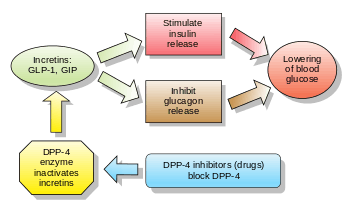Incretin

Incretins are a group of metabolic hormones that stimulate a decrease in blood glucose levels. Incretins do so by causing an increase in the amount of insulin released from pancreatic beta cells of the islets of Langerhans after eating, before blood glucose levels become elevated. They also slow the rate of absorption of nutrients into the blood stream by reducing gastric emptying and may directly reduce food intake. They also inhibit glucagon release from the alpha cells of the islets of Langerhans. The two main candidate molecules that fulfill criteria for an incretin are the intestinal peptides glucagon-like peptide-1 (GLP-1) and gastric inhibitory peptide (also known as: glucose-dependent insulinotropic polypeptide or GIP). Both GLP-1 and GIP are rapidly inactivated by the enzyme dipeptidyl peptidase-4 (DPP-4); both GLP-1 and GIP are members of the glucagon peptide superfamily.[1][2][3]
"Many factors stimulate insulin secretion, but the main one is blood glucose. Incretins, especially GIP and GLP-1 secreted, respectively, by K and L cells in the gut are also important" (Rang and Dale's Pharmacology (2015)).
GLP-1 (7-36) amide is not very useful for treatment of type 2 diabetes mellitus, since it must be administered by continuous subcutaneous infusion. Several long-lasting analogs having insulinotropic activity have been developed, and three, exenatide (Byetta) and liraglutide (Victoza), plus exenatide extended-release (Bydureon), have been approved for use in the U.S. The main disadvantage of these GLP-1 analogs is they must be administered by subcutaneous injection.
Another approach is to inhibit the enzyme that inactivates GLP-1 and GIP, DPP-4. Several DPP-4 inhibitors that can be taken orally as tablets have been developed.
History
In 1902, Bayliss and Starling proposed that the intestinal mucosa contains a hormone, secretin, that stimulates the exocrine secretion of the pancreas.[4]
See also
- Glucagon-like peptide-1 analogs ("incretin mimetics")
- Lixisenatide (Lyxumia by Sanofi)
- exenatide (Byetta, Bydureon)
- liraglutide (Victoza)
- albiglutide (Tanzeum)
- Dulaglutide (by Lili)
References
- ↑ Glucagon.com - site of Daniel J. Drucker's laboratory that studies incretins
- ↑ Drucker DJ, Nauck MA (November 2006). "The incretin system: glucagon-like peptide-1 receptor agonists and dipeptidyl peptidase-4 inhibitors in type 2 diabetes". Lancet. 368 (9548): 1696–705. doi:10.1016/S0140-6736(06)69705-5. PMID 17098089.
- ↑ Amori RE, Lau J, Pittas AG (July 2007). "Efficacy and safety of incretin therapy in type 2 diabetes: systematic review and meta-analysis". JAMA. 298 (2): 194–206. doi:10.1001/jama.298.2.194. PMID 17622601.
- ↑ Bayliss W, Starling EH (Sep 12, 1902). "The mechanism of pancreatic secretion" (PDF). J. Physiol. (London). 28 (5): 325–353. doi:10.1113/jphysiol.1902.sp000920. PMC 1540572
 . PMID 16992627.
. PMID 16992627.